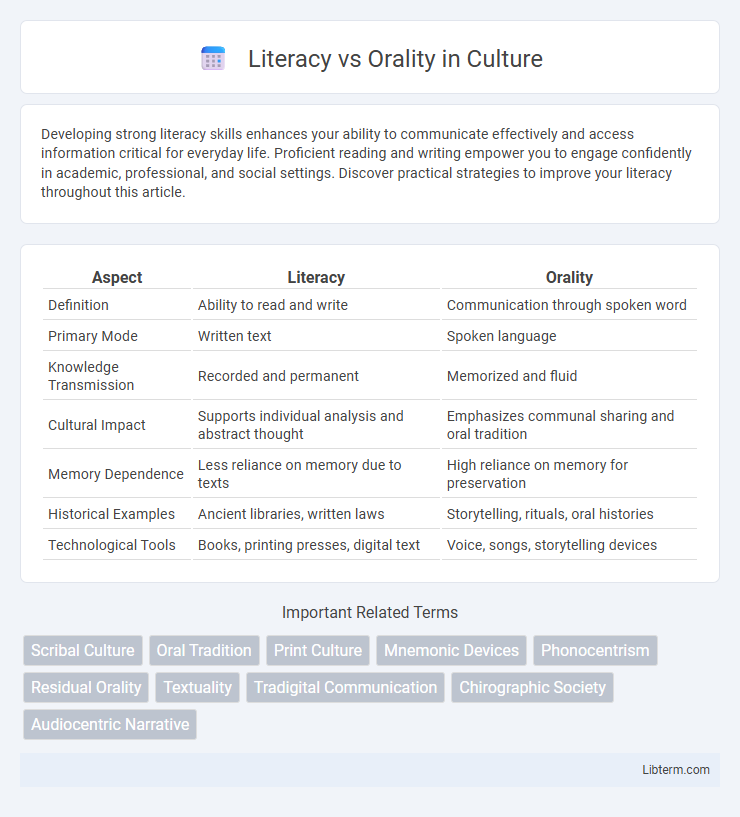Developing strong literacy skills enhances your ability to communicate effectively and access information critical for everyday life. Proficient reading and writing empower you to engage confidently in academic, professional, and social settings. Discover practical strategies to improve your literacy throughout this article.
Table of Comparison
| Aspect | Literacy | Orality |
|---|---|---|
| Definition | Ability to read and write | Communication through spoken word |
| Primary Mode | Written text | Spoken language |
| Knowledge Transmission | Recorded and permanent | Memorized and fluid |
| Cultural Impact | Supports individual analysis and abstract thought | Emphasizes communal sharing and oral tradition |
| Memory Dependence | Less reliance on memory due to texts | High reliance on memory for preservation |
| Historical Examples | Ancient libraries, written laws | Storytelling, rituals, oral histories |
| Technological Tools | Books, printing presses, digital text | Voice, songs, storytelling devices |
Introduction to Literacy and Orality
Literacy, characterized by the ability to read and write, fundamentally transforms communication by enabling the storage and transmission of complex ideas across time and space. Orality, rooted in spoken language and memory, relies on direct interpersonal interaction and communal knowledge transmission. Understanding the distinctions between literacy and orality reveals their profound impact on cognitive processes, culture, and knowledge preservation.
Historical Evolution of Communication
The historical evolution of communication showcases a transition from orality, characterized by spoken word and oral traditions, to literacy, involving the development of written symbols and texts. Early human societies relied predominantly on orality for knowledge transmission, storytelling, and cultural preservation, while the advent of writing systems during the Bronze Age revolutionized communication by enabling the storage and dissemination of complex information across time and space. The shift to literacy facilitated advancements in administration, education, and technology, fundamentally transforming social structures and cognitive processes throughout history.
Defining Literacy: Beyond Reading and Writing
Defining literacy extends beyond the simple ability to read and write, encompassing critical thinking, digital fluency, and communication skills necessary for navigating complex information environments. It involves understanding, interpreting, and producing diverse texts in multiple formats, reflecting cognitive and cultural competencies shaped by both print and digital media. Literacy also integrates orality, recognizing spoken language as a vital mode of communication that influences learning and social interaction.
Understanding Orality: Traditions and Practices
Understanding orality involves recognizing its role as a dynamic system of communication rooted in spoken language, memory, and communal participation. Oral traditions encompass storytelling, rituals, and performance arts that preserve cultural knowledge through repetition, improvisation, and mnemonic devices. This contrasts with literacy's reliance on written texts, highlighting orality's emphasis on interpersonal interaction and contextual meaning in knowledge transmission.
Cognitive Impacts of Literate vs Oral Cultures
Literate cultures enhance abstract thinking and analytical skills through the use of written language, enabling individuals to organize complex information systematically and engage in critical reflection. Oral cultures rely on memory, storytelling, and communal knowledge transmission, fostering strong social bonds and adaptive problem-solving grounded in context. These differing cognitive impacts shape how individuals process information, with literacy promoting linear, decontextualized reasoning and orality supporting relational, context-dependent understanding.
Transmission of Knowledge: Written vs Spoken
Written knowledge transmission enables precise, enduring records accessible across time and space, enhancing cumulative learning and complex analysis. Spoken knowledge relies on dynamic, immediate interaction, fostering communal memory, adaptability, and contextual understanding through oral traditions and storytelling. The contrast highlights how literacy supports formal education and documentation, while orality emphasizes social learning and preservation of cultural identity.
Social Structures and Power in Literacy vs Orality
Literacy functions as a tool for consolidating power within hierarchical social structures by enabling control over written knowledge and institutional communication. Orality reinforces social bonds and communal authority through shared verbal traditions, fostering egalitarian participation and collective memory. The shift from orality to literacy transforms social dynamics by centralizing authority and privileging those who command written language and textual interpretation.
Technological Influences on Literacy and Orality
Technological advancements such as the printing press, digital media, and smartphones have significantly transformed literacy and orality by expanding access to written content and reshaping oral communication through recorded and real-time audio platforms. These technologies facilitate multimodal literacy, integrating text, audio, and visual elements that enhance comprehension and engagement across diverse audiences. The shift from traditional oral storytelling to digital narratives exemplifies how technology bridges orality and literacy, creating hybrid communication forms that influence knowledge dissemination and cultural expression.
Challenges in Preserving Oral Traditions
Oral traditions face significant challenges in preservation due to the transient nature of spoken language and the lack of permanent records. Cultural shifts toward literacy and digital media contribute to the decline of oral storytelling and mnemonic techniques. Efforts to document and archive oral histories rely heavily on audio and video technologies, but capturing the nuances of tone, context, and performance remains difficult.
The Future of Communication: Integrating Text and Speech
The future of communication increasingly blends literacy and orality, leveraging advancements in natural language processing and voice recognition technologies to create seamless interactions. Text-based communication retains precision and permanence, while speech offers immediacy and emotional nuance, enabling richer exchanges across digital platforms. Integrating both modalities supports diverse accessibility needs and fosters more intuitive human-computer interfaces, driving innovations in education, business, and social connectivity.
Literacy Infographic

 libterm.com
libterm.com